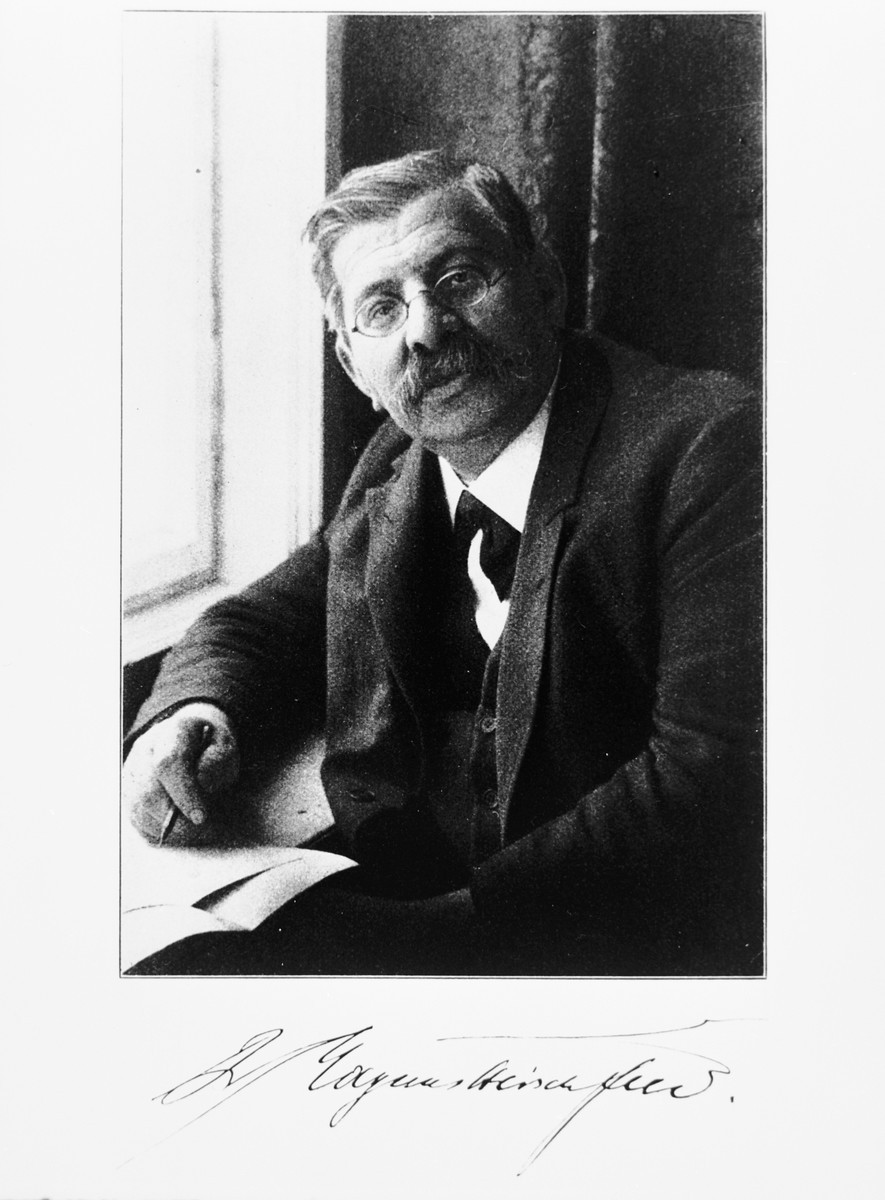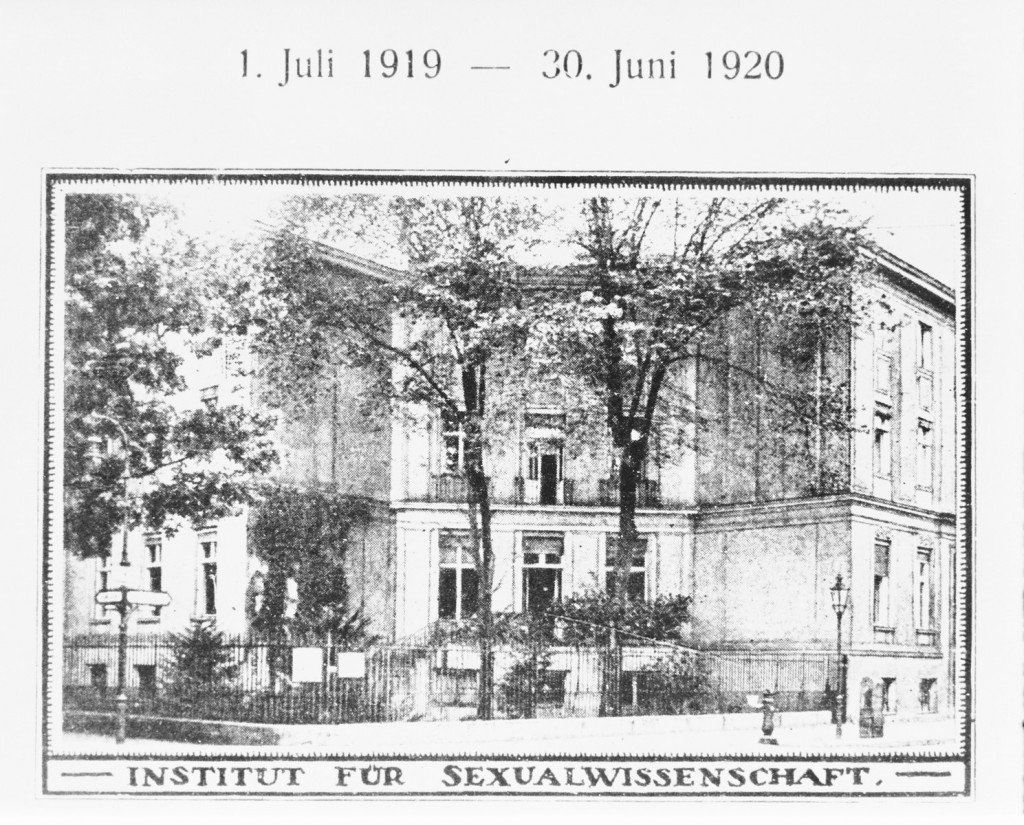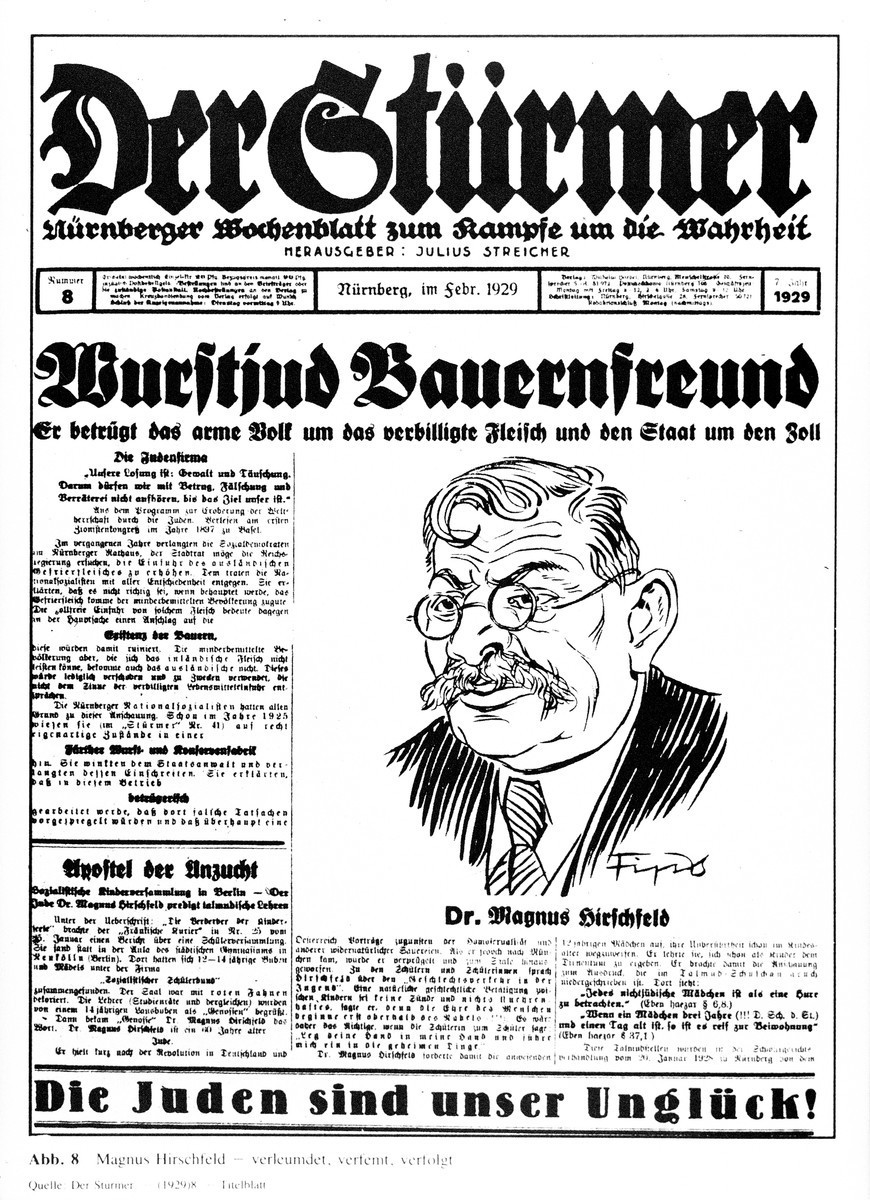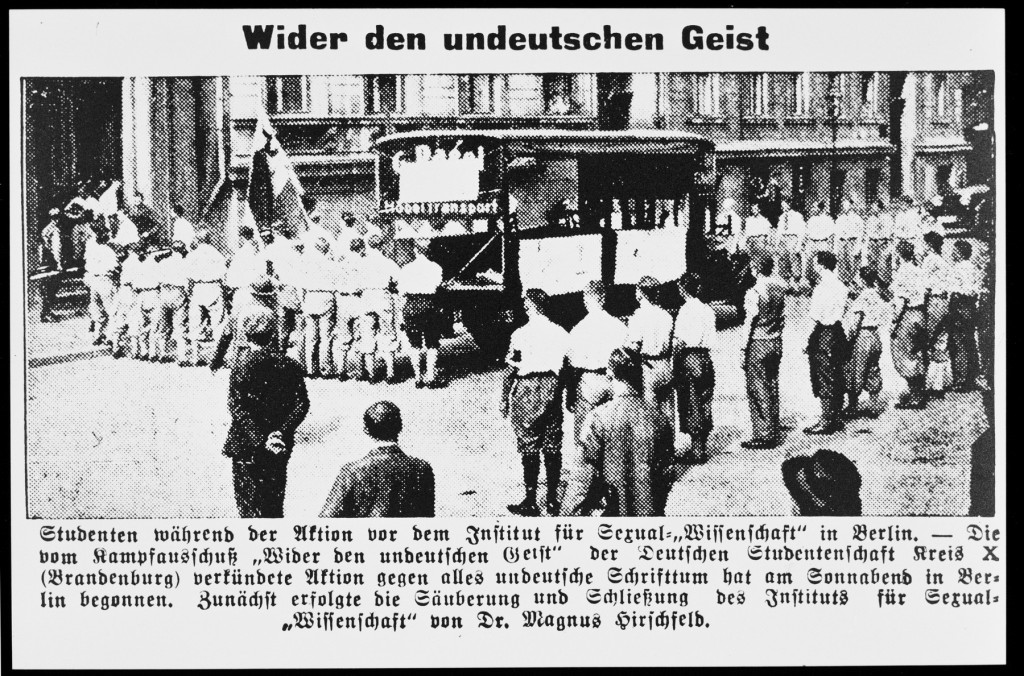Magnus Hirschfeld
Magnus Hirschfeld (1868–1935) was a German Jewish doctor and a leading researcher of sex, sexuality, and gender. He wrote and lectured widely on these topics, treated and advised patients, and worked to promote the rights of those who did not conform to existing gender or sexual norms. After Adolf Hitler was appointed chancellor in 1933, Hirschfeld was forced to live in exile. The Nazis vandalized his Institute for Sexual Science in Berlin and forced it to close.
Key Facts
-
1
Magnus Hirschfeld was a famous doctor who helped pioneer the study of sexuality and gender in the late 1800s and early 1900s.
-
2
Hirschfeld’s belief in the natural diversity of sexual and gender identities was radically different from the traditional views of sexuality and fixed gender roles that were widespread at the time.
-
3
In May 1933, Nazis looted Hirschfeld’s Institute for Sexual Science and destroyed much of the archives in the Berlin book burning.

Magnus Hirschfeld was born into a large Jewish family in 1868 in the German city of Kolberg (the present-day Polish city of Kołobrzeg). He studied medicine and became a doctor in 1892. Hirschfeld’s early work as a physician focused on natural remedies and preventive medicine. However, he soon devoted himself to his lifelong study of sexuality and gender. Hirschfeld never made his own sexuality or his personal life part of his public profile. However, his years-long romantic partnership with Karl Giese would become an open secret later in his life.
Hirschfeld’s ideas about sex, gender, and sexuality were groundbreaking and radical in the late nineteenth and early twentieth centuries. His work represented an emerging trend in Germany as sexual matters began to be discussed and studied more openly. During the Weimar Republic (1918–1933), Hirschfeld became especially prominent. The Nazi Party rejected these new ideas about gender and sexuality. The Nazis frequently attacked Hirschfeld’s work and destroyed many of his files and collections. Hirschfeld’s work is thus a prime example of the science and culture lost to Nazi violence.
Hirschfeld’s Theories of Sexuality and Gender
In the late nineteenth and early twentieth centuries, the nature of human sexuality became an important area of scientific investigation and debate. Germany was at the forefront of this development. Hirschfeld himself became one of the most influential thinkers on the topic. In the late nineteenth century, he began producing pamphlets, books, and journals on sexuality and gender. He wrote these materials in a style meant to reach the general public as well as scholars and medical professionals.
Theories of Sexuality
Hirschfeld pioneered and promoted new theories of sexuality. He was especially interested in the study of same-sex love and desire. Hirschfeld challenged the common idea at the time that same-sex attraction was a pathological perversion and a vice. Instead, he argued that it was innate or inborn (angeboren). Hirschfeld insisted that a person’s sexuality did not determine their character or personality any more than being born left-handed or right-handed did.
Based on his understanding of same-sex attraction as inborn, Hirschfeld argued that consenting adults should not be discriminated against or punished for their sexuality. His work was guided by the motto, “through science to justice.” He believed that his ideas could reduce prejudice and create the public support needed to reform the German criminal code on issues relating to sex. Hirschfeld advocated for the revision of Paragraph 175. This was the statute of the German criminal code that criminalized sexual relations between men.
In 1897, Hirschfeld co-founded the Scientific-Humanitarian Committee (Wissenschaftlich-humanitäres Komitee). For more than 30 years, the committee advocated for the decriminalization of sexual relations between men. The committee repeatedly submitted petitions to revise Paragraph 175. It gathered support from influential citizens and politicians. Ultimately, the Scientific-Humanitarian Committee did not manage to get Paragraph 175 revised. Nonetheless, the committee did spread awareness of its cause. In 1909, it fought against a proposal to criminalize sexual relations between women.
Hirschfeld left the committee in 1929.
Theories of Gender
Hirschfeld was one of the first theorists to promote the concept that a wide variety of gender identities exists. He described a continuous range of unique gender identities, “between which...there are no empty points present but rather unbroken connecting lines.”
As part of his study of gender, Hirschfeld coined the word “Transvestit” (“transvestite”) as a medical and scientific term in 1910. The word came into use in German society at the time as a judgment-free label. However, the term is widely considered offensive today. The German term was an early effort to define non-conforming gender identities. In the late twentieth and twenty-first centuries, LGBTQ+ communities have built on and challenged this language.
Hirschfeld defined “transvestites” broadly as people who wore clothing of a different gender than that assigned to them at birth. This category encompassed a wide range of gender non-conforming people. It included those who occasionally dressed or performed in drag as well as people whose gender identities differed from those assigned to them at birth. In contrast to widely accepted ideas of the time, Hirschfeld asserted that people who identified as “transvestites” were not necessarily attracted to members of the same sex. Rather, he argued that their gender identity was distinct from their sexuality.
In the early twentieth century, communities of people who self-identified as “transvestites” grew in Germany, especially in Berlin. Hirschfeld provided many patients with counseling and support as they explored the complexities of their non-conforming gender identities. He also worked with the Berlin police to issue special passes called “Transvestitenschein” (“transvestite certificates”) to several people. These passes helped protect people from being harassed by the police and arrested for disorderly conduct or other such charges.
Hirschfeld believed that both human sexuality and gender identities were simply examples of natural variation. As such, they should have no stereotypes or judgments attached to them. Hirschfeld sought to promote acceptance of those who did not conform to existing sexual or gender norms. He conducted research, collected data, and spread awareness of his ideas and findings.
Responses to Hirschfeld’s Theories
Hirschfeld became a well-known public figure in the early twentieth century. He was recognized as an expert on sex, sexuality, and gender.
As such, Hirschfeld testified in the libel trials of publisher Maximilian Harden. In 1907, Harden published an article in which he accused two men from Kaiser (Emperor) Wilhelm II’s inner circle of having an affair, and thus violating Paragraph 175. Both men accused Harden of libel. The scandal became known as the Eulenburg Affair, named for one of the men involved. Hirschfeld testified that there was nothing immoral about romantic love between men.
Hirschfeld’s fame did not mean that his ideas were universally accepted by the scientific community or the general public. Many people who shared an interest in the study of sexuality and the reform of Paragraph 175 disagreed with him. At the scientific level, other sex researchers challenged Hirschfeld’s theory that sexuality was determined by biological factors. At the political level, other advocates for the decriminalization of sexual relations between men argued that Hirschfeld’s science-based approach was misguided.
Today, Hirschfeld is widely-recognized as an important pioneer in the study of sexuality and gender. He made many important scientific advances. However, several of his theories have since been discredited and rejected. Like many scientists of his time, Hirschfeld was influenced by theories of eugenics. While he disagreed with some aspects of eugenics, he supported others. For example, Hirschfeld rejected ideas about racial hierarchy. However, he did accept the idea that people diagnosed with chronic alcoholism or certain mental disabilities should not reproduce.
Hirschfeld during the Weimar Republic (1918–1933)

Hirschfeld witnessed the horrors of World War I as a Red Cross physician. He became a devoted pacifist and welcomed the end of the war in 1918. He also supported the foundation of the Weimar Republic, Germany’s democratic government from 1918 to 1933.
Social and political upheaval followed Germany’s defeat in World War I. The country’s cultural and social traditions were challenged during the Weimar era. Many Germans publicly challenged gender and sexual norms. This was especially true in big cities such as Berlin, Hamburg, and Frankfurt am Main.
Hirschfeld’s Institute for Sexual Science
The social atmosphere of the Weimar Republic allowed Hirschfeld to realize a long-cherished goal of opening an institute. In 1919, he established the Institute for Sexual Science (Institut für Sexualwissenschaft). The institute opened in a stately building in the central Tiergarten section of Berlin.
The Institute for Sexual Science was the first facility of its kind. It offered medical care, professional training, research opportunities, and public sex education. It also served as a residence and community center. Hirschfeld had an apartment above the institute. His partner, Karl Giese, was the director of the institute’s library and archive. Many others worked on the staff over the years. Patients who had no means to pay for their treatment sometimes lived and worked at the institute as well.
Hirschfeld worked with many different medical specialists at the institute. They provided treatment for a range of issues related to sex, such as sexually transmitted diseases, unwanted pregnancies, and impotence. Hirschfeld specialized in helping those seeking assistance as they navigated their sexuality or gender identities. He also offered advice on pursuing same-sex relationships. He provided this help at a time when sexual relations between men were against the law. Hirschfeld and other staff also helped develop some of the earliest modern gender affirmation surgeries.
The institute held Hirschfeld’s collection of books and artifacts on sex. Its library and collections were accessible to interested members of the public. They became a kind of tourist destination for the curious. Many writers, artists, and other well-known figures visited the institute. As a community center, the building also offered public education programs and events. Hirschfeld, Giese, and other staff members regularly hosted lectures, film screenings, and discussion evenings.
Attacks on Hirschfeld during the Weimar Republic

While many Germans embraced Hirschfeld’s work, others found it scandalous. His work was frequently attacked in the press. Large numbers of Germans were opposed to public discussions of sex and sexuality. They viewed such debates as decadent, overly permissive, and immoral. Many were disturbed by the increased visibility of sex in advertising, film, and other aspects of daily life in the Weimar Republic. For many, Hirschfeld and his institute symbolized what they saw as Weimar’s overly sexualized culture.
Hirschfeld was also targeted because of his Jewish ancestry and his sexuality. This occurred even though he did not observe Jewish cultural or religious traditions and never made his private life part of his public persona. Hirschfeld even became the victim of violent right-wing assaults during the 1920s. In 1921, he was badly beaten in Munich. A newspaper article celebrated the assault and warned that “the next time his skull might be crushed.”
In 1930, Hirschfeld placed Giese in charge of the Institute for Sexual Science. He left Germany and embarked on a global lecture tour. He traveled to the United States, Japan, China, the Philippines, Indonesia, India, Egypt, and Palestine.
When Hirschfeld returned to Europe in 1932, he received threats and warnings to stay away from Germany. The growing influence of the Nazi Party made Germany a potentially dangerous place for him. Nazi propagandists used him as a prime example of what they called degenerate Jewish sexuality. Hirschfeld had always been extremely proud of being German. However, he realized that he would no longer be safe in Germany. Hirschfeld settled in Switzerland shortly before Hitler was appointed as chancellor of Germany on January 30, 1933. Hirschfeld recorded his reaction to being forced into exile: “If Germany doesn't want me, I don't want it either.”
The Nazis and the End of the Institute for Sexual Science
In 1933, the Nazi regime began to crack down on what they saw as un-German ideas. Hirschfeld and the Institute for Sexual Science were subject to Nazi attacks on a number of fronts. The Nazis hated Hirschfeld for his pacifism, his Jewish ancestry, and his ideas about sex, gender, and sexuality.
On May 6, 1933, a Nazi student group marched to the Institute for Sexual Science in Berlin. With members of the SA, they ransacked the institute and looted its library and archives. Days later, the stolen books, artifacts, and clinical files were destroyed in one of several public book burnings organized across Germany. A bust of Hirschfeld was paraded through the streets on a stick before being thrown onto the bonfire. Within months, Nazi authorities forced the Institute for Sexual Science to close.
Hirschfeld never returned to Germany. Experiencing several health issues, he relocated to the Mediterranean coast of France for its warm climate. Hirschfeld died in Nice in 1935. Nazi propaganda continued to attack him for several years. Hirschfeld remained a symbol of the supposedly decadent and un-German culture that the Nazis condemned.

Legacy
Much of Hirschfeld’s lifework was lost when the Institute for Sexual Science was ransacked and forced to close. However, his publications and ideas continued to influence the study of sexuality and gender after his death. In recent decades, Hirschfeld has been increasingly recognized as an early pioneer of the movement for LGBTQ+ rights.

